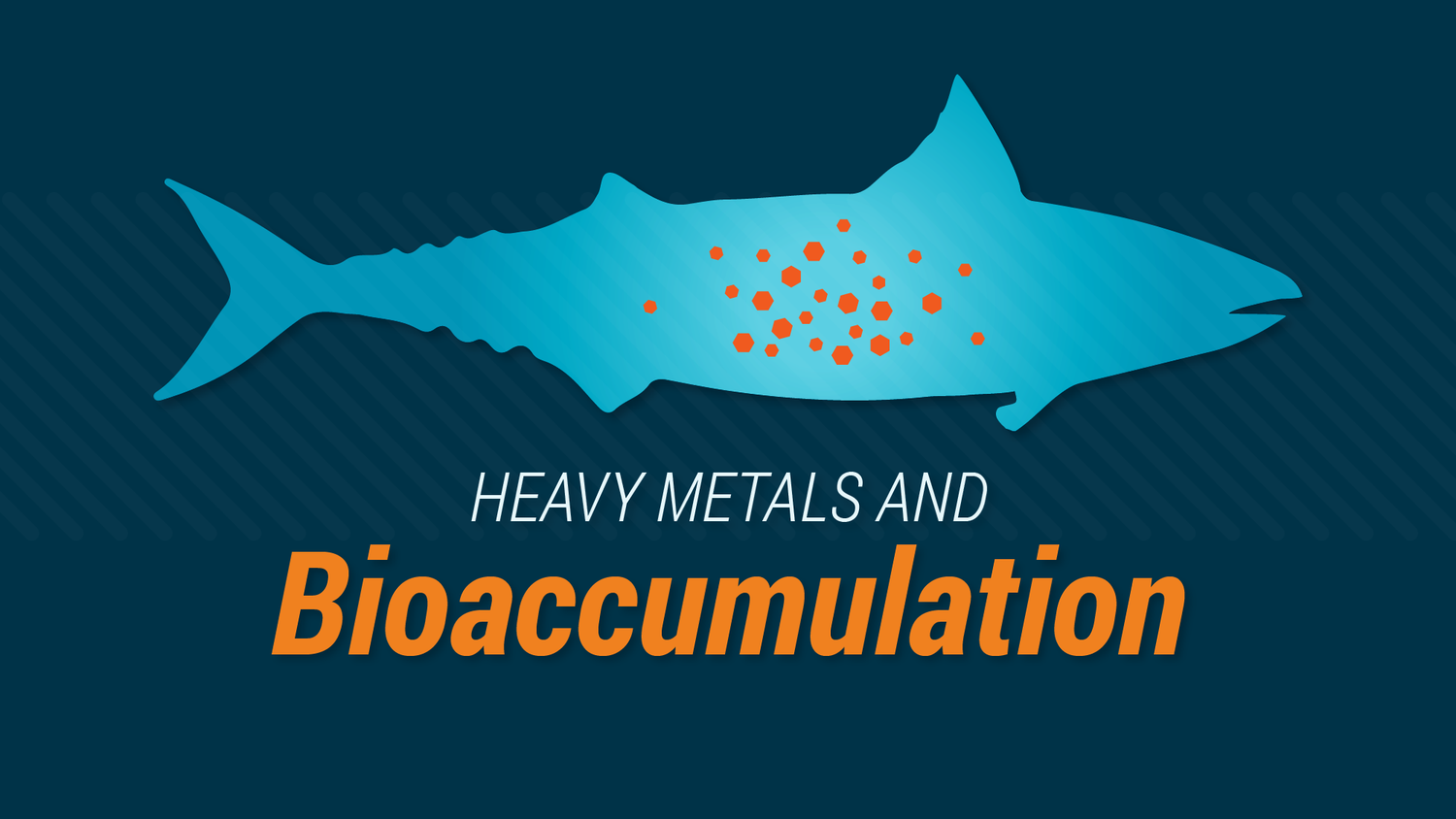
Heavy Metals And Bioaccumulation: What You Need to Know
Our blog is written by real experts— not AI. Each guide is carefully reviewed and updated based on the latest research. Plus, with no affiliate links, you can count on unbiased insights you can trust.
Picture the food web: an interconnected tangle of species, all relying on each other for energy and nutrients. Though most of what gets passed along from the tiniest microbes to humans enables us to live, a small fraction of it can be toxic.
Why Heavy Metals Accumulate in Your Food and Your Body
Heavy metals are natural elements that are poisonous to humans at high doses. They enter our bodies mainly from lower down on the food chain through a process called bioaccumulation.
What are heavy metals, and what does it mean for them to bioaccumulate? Why is heavy metals bioaccumulation dangerous for your health? We’ve got the answers–and some tips on what to do.
What Are Heavy Metals?
Heavy metals are present in earth’s crust alongside other metals, minerals, and organic matter. Some examples include: mercury, lead, arsenic, cadmium, chromium, copper, and thallium. Heavy metals are defined as “heavy” in comparison to water, meaning that they have a higher molecular weight than 18 g/mol. Heavy metals also find their way into watersheds from concentrated wastewater, sewage, industrial activities, and mining operations. These metals can contaminate soil systems and water sources.
People are exposed to heavy metals in a few different ways, primarily through drinking water or ingesting food (crops can uptake metals from contaminated soil or meat and fish products may contain bioaccumulated metals). Many heavy metals are poisonous to humans, even in small concentrations.
Heavy Metals Everyone Should Test
What Is Bioaccumulation?
Bioaccumulation is essentially the buildup of contaminants such as heavy metals or pesticides in living organisms. Aquatic organisms are often subject to bioaccumulation because they absorb contaminants from the water around them faster than their bodies are able to excrete them.
Humans are also subject to bioaccumulation, either from consuming contaminated aquatic organisms or from exposure to contaminants in our food, air, or water. Heavy metals do not biodegrade, which means they can last for a long time in our bodies.
How Does Bioaccumulation Affect the Food Chain?
Bioaccumulation in the food chain begins with the smallest microorganisms and ends with humans. Heavy metals are able to bind to the surface of microorganisms (like phytoplankton in oceans) and sometimes enter the cells themselves.
Once they enter the cell, heavy metals can react with chemicals released by the microorganism to digest food, and undergo chemical transformations. (An example is mercury becoming methylmercury, which is especially dangerous because methylmercury is more easily absorbed by living organisms.) Insects and zooplankton eat microorganisms, fish eat zooplankton, and eventually humans order a tuna to eat at a restaurant!

At every point in this process, heavy metals bioaccumulate in the bodies of each living organism—by the time they get to us, we consume the heavy metals in high concentrations. The increase of heavy metals concentration up the food chain is called biomagnification.
Health Effects of Heavy Metals
Unfortunately, heavy metals can have serious health effects for humans. Many play a role in cancer development or cause internal organ damage, even at low concentrations. Cadmium, cobalt, lead, nickel, and mercury are also known to affect the formation of blood cells: the metals can react with the surface of the cells, making them less elastic and therefore less able to circulate throughout the body.
We’ve summarized five critical heavy metals and their known health effects:
Mercury
Mercury is known to cause brain damage in developing children, and if you’re pregnant, it can cause birth defects or possibly a miscarriage. Methylmercury compounds are also known to cause cancer. There is a deep concern about mercury exposure through predatory fish such as tuna, which is the second most popular fish in the US.
An example to demonstrate the magnitude of the issue is if a 45 lb child eats one 6 oz can of white tuna per week, the child is already exceeding the US Environmental Protection Agency (EPA) mercury limit.
Lead
Lead is particularly harmful for children. It is structurally similar to calcium and can therefore replace calcium in the growing bones of children. Once the child is grown, the lead can release into the body and cause brain and nerve damage. Lead can also cause anaemia, reproductive issues, and renal impairment.
People are usually exposed to lead through contaminated food or water, or in the case of children, from ingesting objects with lead paint. Lead can be expelled at very low levels, but at high or continuous doses, lead bioaccumulates in the body.
(The Ultimate Guide to Lead—SimpleLab Tap Score)
Cadmium
Cadmium remains in human bodies for decades, and long-term exposure is linked to renal dysfunction. A high concentration exposure can also lead to bone defects and lung disease, which may eventually become lung cancer. People can be exposed to cadmium not only through food and water, but also from tobacco in cigarettes.
Chromium
At low levels, chromium only causes skin irritation and ulcers. Longer-term exposure, however, can lead to liver issues, renal tubular damage, and cancer. Similar to mercury, chromium easily accumulates in aquatic life.
Arsenic
Arsenic is technically considered a metalloid, but acts like a heavy metal in its toxicology. Arsenic exposure can cause breathing problems, lung and skin cancer, decreased IQ, nervous system issues, and even death at high levels. Arsenic easily enters groundwater and soils from natural sources and industrial operations. Some crops can uptake arsenic after irrigation or from the soil, an example being rice, leading to exposure through food.
(The Ultimate Guide to Arsenic—SimpleLab Tap Score)
How to Reduce Your Exposure to Heavy Metals
Though these health effects may seem frightening, there are a few simple ways to reduce your exposure to heavy metals and protect your health! A few include:
- Avoid certain fish: Specifically, fish that are high in mercury such as king mackerel, swordfish, marlin, & tilefish. It is particularly important to reduce tuna consumption, especially in the form of tuna steaks or canned white albacore. For other options, check out this guide to eating sustainable and lower-risk fish.
- Read medicine labels: Some may contain heavy metals as ingredients.
- Minimize rice consumption: There is evidence that rice contains arsenic and thus increases cancer risk. Rinsing rice before cooking may reduce risk.
- Stop smoking tobacco: Arsenic, lead, and cadmium levels have been detected in cigarettes and e-cigarette vaporizers.
- Be aware of lead pipes & filter your water: This concept is addressed further in Part 2 of this article, where we’ll focus on heavy metal exposure and remediation. Essentially, because heavy metals can enter groundwater or leach from pipes, it is important to filter them out before drinking water.
Article Sources
▾
https://saferchemicals.org/get-the-facts/chemicals-of-concern/heavy-metals-2/
https://www.ncbi.nlm.nih.gov/pmc/articles/PMC4144270/
https://www.fda.gov/downloads/Food/FoodScienceResearch/RiskSafetyAssessment/UCM486543.pdf
https://www.sciencedirect.com/science/article/pii/S2214750014001292
https://www.whoi.edu/oceanus/feature/how-does-toxic-mercury-get-into-fish
https://data.web.health.state.mn.us/lead










